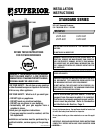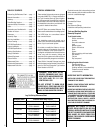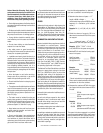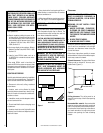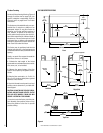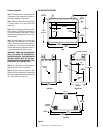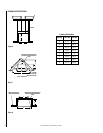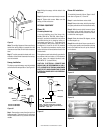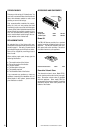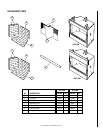
NOTE: DIAGRAMS & ILLUSTRATION NOT TO SCALE.
3
Use the following equations to determine if
you have a confined or unconfined space.
1.Determine the volume of space — ft
3
.
Length x Width x Height = _____ ft
3
(Include adjoining rooms with doorless pas-
sageways or ventilation grills between
rooms.)
Example: 24' (L) x 16' (W) x 8' (H) = 3072
ft
3
2.Divide the volume of space by 50 ft
3
to
determine the maximum BTU/Hr the space
can support.
______ (volume of space – ft
3
)/ 50 ft
3
=
(Maximum BTU/Hr the space can support)
Example: 3072 ft
3
/ 50 ft
3
= 61.44
or 61,440 BTU/Hr the space can support.
3.Add the BTU/Hr of all the fuel burning appli-
ances in the space.
Vent-Free heater _______ BTU/Hr
Gas appliance #1* _______ BTU/Hr
Gas appliance #2 + _______ BTU/Hr
Total = _______ BTU/Hr
Example:
Vent-free heater 26,000 BTU/Hr
Gas appliance #1 40,000 BTU/Hr
(water heater)
Total = 66,000 BTU/Hr
* Do not include direct-vent gas appliances.
Direct-vent is sealed combustion and draws
combustion air from the outdoors.
4. Compare the maximum BTU/Hr the space
can support with the actual amount of BTU/
Hr used.
_________ BTU/Hr
(max. the space can support)
_________ BTU/Hr
(actual amount of BTU/Hr used)
Example:
61,440 BTU/Hr
(max. the space can support)
66,000 BTU/Hr
(actual amount of BTU/Hr used)
The space in the above example is a confined
space because the actual BTU/Hr used is more
than the maximum BTU/Hr the space can sup-
port. You must provide additional fresh air.
Carbon Monoxide Poisoning: Early signs of
carbon monoxide poisoning are similar to the
flu with headaches, dizziness and/or nausea.
If you have these signs, obtain fresh air im-
mediately. Have the Unvented Gas Heater
serviced as it may not be operating correctly.
• Due to high temperatures, the firebox should
be located out of traffic and away from furniture
and draperies.
• Children and adults should be alerted to the
hazard of high surface temperature and should
stay away to avoid burns or clothing ignition.
• Young children should be carefully super-
vised when they are in the same room with the
heater.
• Do not place clothing or other flammable
material on or near the heater.
• Any safety screen or guard removed for
servicing the firebox must be replaced and/or
closed prior to operating the heater.
• Installation and repair should be done by a
qualified service person. The heater should be
inspected before use and at least annually by
a professional service person. More frequent
cleaning may be required due to excessive lint
from carpeting, bedding material, etc. It is
important that control compartments, burners
and circulating air passageways of the heater
be kept clean.
• Allow the heater to cool before servicing.
Always shut off any electricity or gas to the
heater while performing service work.
• Do not install the firebox in a sleeping room
or bathroom.
• The appliance and its individual shut-off valve
must be disconnected from the gas supply
piping system while performing any tests of the
gas supply piping system at pressures in ex-
cess of ¹⁄₂ psig.
• The heater must be isolated from the gas
supply piping system by closing its individual
manual shut-off valve during any pressure test-
ing of the gas supply piping system at test
pressures equal to or less than ¹⁄₂ psig.
• Keep heater area clear and free from com-
bustible materials, gasoline and other flam-
mable vapors and liquids.
• Do not use this heater if any part has been
under water. Immediately call a qualified ser-
vice technician to inspect the heater and to
replace any part of the control system and any
gas control which has been under water.
• Ensure that the heater is clean when operat-
ing. Excessive dust accumulation on the burner
and logs will increase the amount of carbon
monoxide formation and could lead to carbon
monoxide poisoning and death.
CODES
Adhere to all local codes or in their absence the
latest edition of The National Fuel Gas Code
ANSI Z223.1 or NFPA54 which can be obtained
from The American National Standards Insti-
tute, Inc. (1430 Broadway, New York, NY,
10018) or National Fire Protection Association,
Inc. (Batterymarch Park, Quincy, MA, 02269).
COMBUSTION AND VENTILATION AIR
Heaters installed in these appliances shall not
be installed in a confined space. Heaters
installed in these appliances may be located
in unusually tight construction provided the
space is unconfined, or if confined, is pro-
vided with two permanent openings commu-
nicating directly with an additional room(s)
of sufficient volume so that the combined
volume of all connected spaces meets the
criteria for an unconfined space, (National
Fuel Gas Code ANSI Z223.1 1992, Section
5.3). Generally 50 ft
3
per 1,000 BTU input of
all operating appliances in the space.
The National Fuel Gas Code defines a confined
space as a space whose volume is less than
50 ft
3
per 1,000 BTU/Hr (4.8 m
3
per kw) of the
aggregate input rating of all appliances in-
stalled in that space and an unconfined space
as a space whose volume is not less than 50 ft
3
per 1,000 BTU/Hr (4.8 m
3
per kw) of the aggre-
gate input rating of all appliances installed in
that space. Rooms communicating directly with
the space in which the appliances are installed,
through openings not furnished with doors, are
considered a part of the unconfined space.
Unusually tight construction is defined as con-
struction where:
a. wall and ceilings exposed to the outside
atmosphere have a continuous water vapor
retarder with a rating or one perm or less with
openings gasketed or sealed, and
b. weather stripping has been added on oper-
able windows and doors, and
c. caulking or sealants are applied to areas such
as joints around window and door frames,
between sole plates and floors, between wall-
ceiling joints, between wall panels, at penetra-
tions for plumbing, electrical, and gas lines,
and at other openings.



